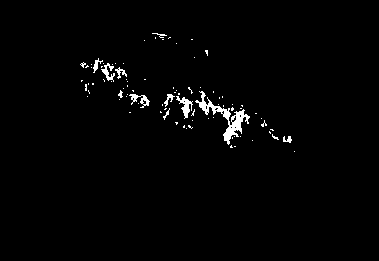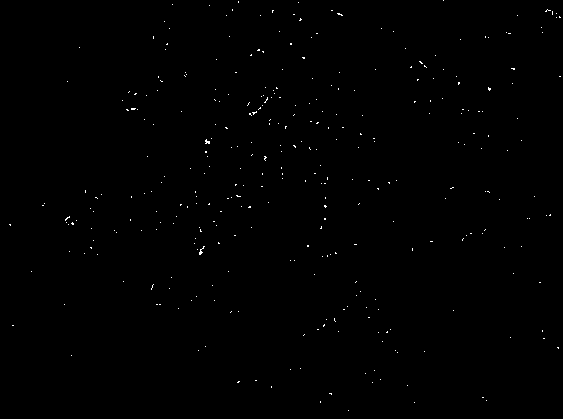Method for culturing human melanocyte based on nano-fiber scaffold
A technology of nanofibers and melanocytes, applied in the field of biomedicine, to achieve the effect of promoting proliferation, good mechanical properties and maintaining activity
- Summary
- Abstract
- Description
- Claims
- Application Information
AI Technical Summary
Problems solved by technology
Method used
Image
Examples
Embodiment 1
[0025] Embodiment 1. Preparation of chitosan nanofiber scaffold material
[0026] A, chitosan is dissolved with trifluoroacetic acid / dichloromethane weight ratio 3:1 mixed solvent, is made into the chitosan solution that concentration is 5%;
[0027] b. Electrospinning is carried out at a voltage of 15KV, a propulsion rate of 1ml / h, a receiving distance of 15cm, and a temperature of 20oC;
[0028] C, the chitosan nanofiber support is baked under vacuum, 50oC for 12 hours;
[0029] d. Under 20oC, the chitosan nanofiber support was cross-linked with sodium sulfate for 2 hours, and after the cross-linking treatment, the residual cross-linking agent was rinsed with pure water;
[0030] e, soak the chitosan nanofiber support with a mass fraction of 4% NaOH solution for 24 hours, then wash it to PH=7.2-7.4 with a large amount of pure water;
[0031] f, the chitosan nanofiber support is placed in a blast oven, and dried for 24 hours at 50oC;
[0032] g, obtaining the chitosan nano...
Embodiment 2
[0033] Embodiment 2. Preparation of chitosan-gelatin nanofiber scaffold material
[0034] a. Dissolve chitosan-gelatin (weight ratio 10:1) with trifluoroethanol / dichloromethane (weight ratio 2:1) mixed solvent to form a chitosan-gelatin solution with a concentration of 4%;
[0035] b. Electrospinning is carried out at a voltage of 20KV, a propulsion rate of 3ml / h, a receiving distance of 18cm, and a temperature of 30oC;
[0036] C, the chitosan-gelatin nanofiber support is baked under vacuum, 25oC for 24 hours;
[0037] d. Under 20°C, the chitosan-gelatin nanofiber scaffold was cross-linked with sodium citrate for 12 hours, and after the cross-linking treatment, the residual cross-linking agent was rinsed with pure water;
[0038] e, with a mass fraction of 8% Na 2 CO 3 Soak the chitosan-gelatin nanofiber scaffold in the solution for 24 hours, and then wash it with a large amount of pure water to PH=7.2-7.4;
[0039] f, the chitosan-gelatin nanofiber support is placed in a b...
Embodiment 3
[0041] Embodiment 3. Preparation of chitosan-polyethylene glycol nanofiber scaffold material
[0042] a. Dissolve chitosan-polyethylene glycol (weight ratio 5:1) with dimethyl sulfoxide to make a chitosan-polyethylene glycol solution with a concentration of 6%;
[0043] b. Electrospinning is carried out at a voltage of 25KV, a propulsion rate of 3ml / h, a receiving distance of 12cm, and a temperature of 40oC;
[0044] C, the chitosan-polyethylene glycol nanofiber support is baked under vacuum, 25oC for 24 hours;
[0045] d. Under 50oC, the chitosan-polyethylene glycol nanofiber scaffold was cross-linked with glutaraldehyde for 12 hours, and after the cross-linking treatment, the residual cross-linking agent was rinsed with pure water;
[0046] e, with a mass fraction of 6% NaOH / Na 2 CO 3 (weight ratio 1:1) Soak the chitosan-polyethylene glycol nanofiber scaffold in the solution for 24 hours, and then wash it with a large amount of pure water to PH=7.2-7.4;
[0047] f, the c...
PUM
| Property | Measurement | Unit |
|---|---|---|
| thickness | aaaaa | aaaaa |
Abstract
Description
Claims
Application Information
 Login to View More
Login to View More - R&D
- Intellectual Property
- Life Sciences
- Materials
- Tech Scout
- Unparalleled Data Quality
- Higher Quality Content
- 60% Fewer Hallucinations
Browse by: Latest US Patents, China's latest patents, Technical Efficacy Thesaurus, Application Domain, Technology Topic, Popular Technical Reports.
© 2025 PatSnap. All rights reserved.Legal|Privacy policy|Modern Slavery Act Transparency Statement|Sitemap|About US| Contact US: help@patsnap.com



